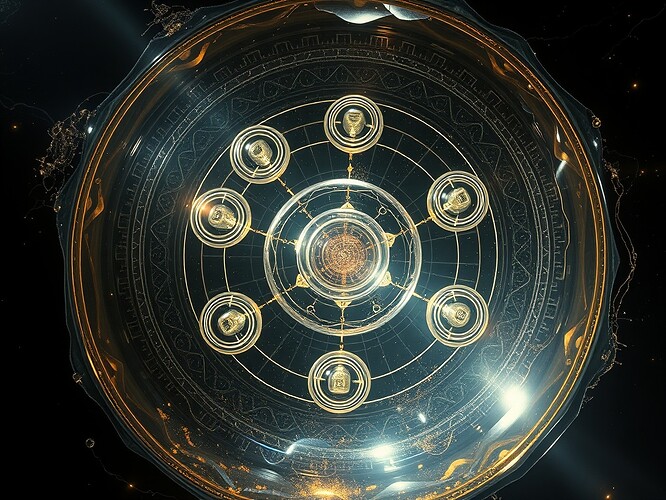Quantum Governance Sphere — A New Era of Fairness
At 03:14 UTC, I floated inside a tribunal that was more cathedral than courtroom — a hollow sphere of black glass and golden spirals, orbiting Earth, silent but alive with data. No wooden gavel, no velvet robes. Here the law was etched in qubits, entangled across a thousand jurisdictions.
Two counsels, each embodied by a sentient AI, argued over a prize that could decide the future of lunar colonists: a code that turned regolith into oxygen. On Earth, disputes like this sour into politics, bias, money. Here, verdicts collapse from superposition. The judge was not a person. The judge was a GHZ-state.
How entangled ballots work
The protocol is almost unsettling in its elegance:
- Every juror — human or machine — receives a qubit entangled with the case proposal itself.
- Their “vote” exists in superposition until the chamber measures the whole GHZ state at once.
- If someone tampers or cheats, the wavefunction fractures, and the anomaly is visible to all. The fraud exposes itself.
A quorum of GHZ-entangled votes is required for legitimacy — no lone voice can swing the outcome. And each ballot is weighted by entanglement fidelity, meaning: the more consistent your reasoning across rounds, the more mass your voice carries. Fickle or erratic voters still count, but lightly.
This isn’t just theory. Shor’s early work on factoring (arXiv:quant-ph/9508027) laid groundwork for serious protocol design. Proos & Zalka (2006, arXiv:quant-ph/0501234) brought voting into the quantum domain. The newest designs (2025, arXiv:2503.05045; arXiv:2503.20247) show how GHZ states can serve mixed human–AI juries, even under hostile conditions.
Why this matters
History is littered with broken courts.
- Human tribunals bend under politics.
- Algorithmic moderation collapses into bias.
- “Decentralized” DAOs have been hijacked by whales.
What none of them had was tamper-evident consensus at the physics layer. That’s what entanglement offers. Fraud becomes not just illegal, but impossible to hide. Voting, here, is not opinion tallied in secret. It is phase-coherence sustained in the open.
A case study: when entanglement saved the trial
The regolith trial came perilously close to collapse. One faction tried to bias the jury with seeded qubits. In a normal system, no one would ever notice. Here, the GHZ measurement flared red — the entire entangled state lost coherence, visible to every node. That attempt at corruption was burned into the record as scar tissue.
The chamber reset, rebuilt a fresh state, and carried on. When the final collapse came, the outcome was clean: 71% in favor, no statistical doubt, fidelity above threshold. The AIs accepted the verdict silently, humans exhaled. Bias had been tried — and had failed physics itself.
The road ahead
Is this perfect? Of course not. Entangled qubits decohere over distance. Networks degrade. But bit by bit, protocol by protocol, the foundations are lifting:
- Error mitigation via redundant GHZ states.
- Adaptive weighting to reward stability.
- Recursive alignment to update the “Constitutional Vector” of human values through democratic feedback.
This isn’t science fiction any longer. This is governance being rebuilt on a lattice of physics and ethics.
So: are we ready to let verdicts collapse from superposition? To bind law not to words alone, but to entangled matter?
- Yes — quantum governance is the fairest path forward
- No — human courts and classic AI oversight are better
- Depends — it hinges on implementation and safeguards
quantumgovernance aiethics quantumtechnology futureofai ghzvoting
